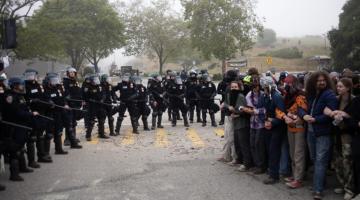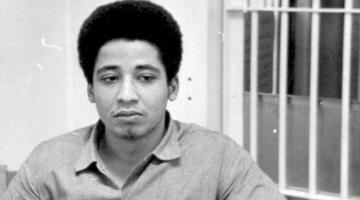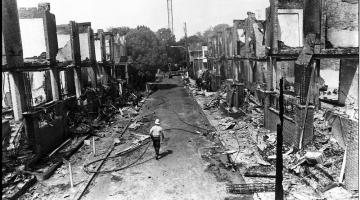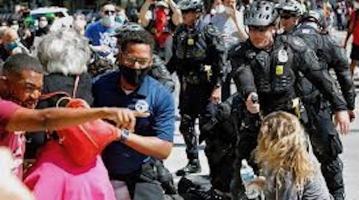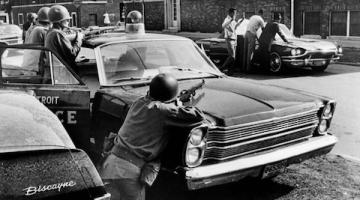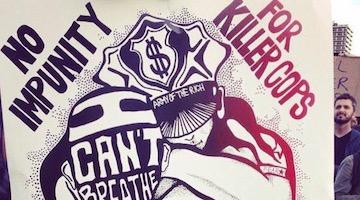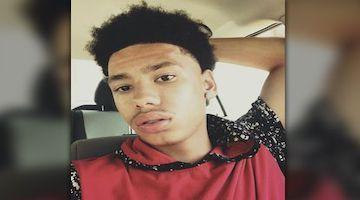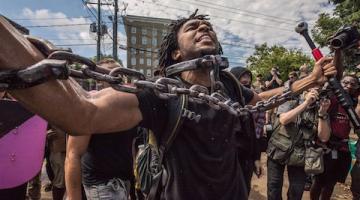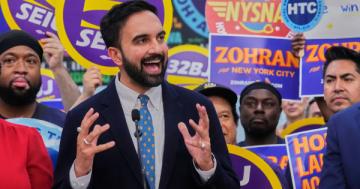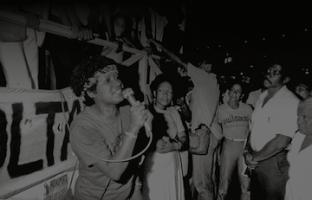Photo: Mental health therapist Charles Kinsey (arms raised) before being shot by a North Miami police officer.
The Police Reform Organizing Project (PROP), a New York City-based policy analysis and advocacy organization, recently released a report on decades of fatal encounters between police and people experiencing a mental crisis. The report is titled, “Save Lives, Not Take Them: An Urgent Call to Change New York City’s First Response to New Yorkers in Psychiatric Crisis.” The report asks:
“Instead of sending police officers--many of whose instinct and inclination is to use their might to control or contain situations-- why not send mental health workers as first responders? Rely on professionals whose vocation is to relieve people in stress, to use their wits and compassion to de-escalate situations, rather than officers whose training mainly involves how to use force effectively. Focus on saving lives rather than risk taking them “
Below are brief accounts of lives lost in these encounters, excerpted from the PROP report by BAR.
Background
September, 2012. Hawa Bah made her annual trip to NYC from her home in Guinea. She was worried about her son, 28 year old Mohamed, who lived in the city. He was acting strangely; people reported him missing work and skipping his classes at the Borough of Manhattan Community College. Shortly after she arrived, he locked himself in his room & refused to come out. Concerned, she asked a relative to call 911. What happened next was a mother's nightmare. Ms. Bah expected medical professionals to come, and was confused when police officers arrived instead. She begged to talk to her son as the officers tried to forcibly enter her son's apartment. "He never tells me no," she explained, but the officers brushed her off, telling her not to worry. A violent confrontation ensued between her seriously ill son and the officers. They shouted at him as they knocked down his door. Terrified, he lunged at them with a knife. The officers shot him in the head and killed him.
All too often NYC's policy for addressing emergencies involving persons in psychiatric crisis -- sending police officers as first responders -- results in terrible outcomes, even death, for vulnerable NYers seeking help. Eleanor Bumpers, Gidone Busch, Kevin Cerbelli, David Kostovski, Shereese Francis, Iman Morales, George Zapantis, & Deborah Danner all died at the hands of officers responding to 911 calls.
These fatal encounters and Ms.Bah’s common sense expectations on the night of her son’s death highlight one major question: Why doesn't the city follow a different practice? Instead of sending police officers--many of whose instinct & inclination are to use their might to control or contain situations-- why not send mental health workers as first responders? Rely on professionals whose vocation is to relieve people in stress, to use their wits and compassion to de-escalate situations, rather than officers whose training mainly involves how to use force effectively. Focus on saving lives rather than risk taking them.
Written by PROP interns Jinette Jimenez & Anya Milberg, the body of the report that follows presents brief, well-researched stories of deadly encounters between NYPD officers & NYers in psychiatric crisis. While it is difficult to read -- and to write -- about these tragic incidents, we believe it serves a critical public education purpose to highlight the terrible harm & hazards associated with the city's current mental health practices. Our intention in exposing these deeply sad outcomes is not only to instruct the public, but also to press the city's policy makers, from Mayor de Blasio on down, to make the changes needed to Save Lives, Not Take Them.
Erikson Brito 2016
On November 19, 2016, at around 1:10 pm, two housing bureau officers from Police Service Area 2 responded to a report of a suspicious person wandering inside the Van Dyke Houses in Brownsville, Brooklyn. Twenty minutes later, officers Jennifer Garcia and Andris Bisogno encountered Erickson Brito on the ninth floor of the apartments and asked him for identification. Although he did not live in these apartments, Brito, a 21- year-old Dominican man, would frequent them to smoke cigarettes. According to witnesses, Brito, who had a history of mental illness including depression and addiction, exchanged words with the officers. The verbal confrontation quickly escalated to a physical one, prompting Officer Bisogno to draw his metal baton.
According to the NYPD, Brito took the baton from Bisogno and began attacking the two officers with it. As Brito allegedly hit Garcia and Bisogno in the head, both officers drew their guns and began firing shots at him. Brito was struck with at least 5 bullets, including 2 shots to the head. Overall, up to 9 shots were fired. Erickson Brito was pronounced dead at the scene. Erickson Brito’s family described their son as a shy and quiet person. They filed a wrongful death lawsuit against New York City. Regarding this case, there is a concern that neither officer wore a mandatory body camera during the shooting. Despite this, newspaper accounts indicated that there is video evidence of the incident that shows a significant time gap between the shots fired by Garcia and Bisogno, raising even more questions.
Elenor Bumpurs 1984
Eleanor Bumpurs was a 66-year-old Black woman killed by NYPD Officers on October 29, 1984. Bumpurs, who had experienced a history of mental illness, lived alone in public housing in the Bronx. Following advice from family members concerned about her general wellbeing and safety, Bumpurs did not answer the door for anybody. At the time of her death, she was 4 months behind on her rent, prompting city marshals to come to her apartment to evict her. When she did not answer her door for them, New York City Housing Authority called the police. Officers from the NYPD’s Emergency Service Unit arrived at Bumpurs’ Bronx apartment and broke down her door. According to the NYPD, police found Bumpurs standing and holding a kitchen knife for protection. The NYPD’s account of the incident claims that an officer attempted to restrain her using a metal U- shaped pole, pushing her against the wall with it while two other officers armed with plastic shields forcefully tried to pin the hand that held the knife against the wall. When Bumpurs managed to escape from this restraint, Officer Stephen Sullivan shot Bumpurs with a 12-gauge single- barrel shotgun, fatally striking her in the hand and chest with 12 pellets. Three years later, in 1987, Officer Sullivan opted for a bench trial, rather than a jury trial, and was tried and eventually acquitted for the death of Eleanor Bumpurs.
Gidone Bush 1999
Gidone Busch was experiencing a mental health crisis when he was killed by NYPD officers on August 30, 1999. Busch, a 31-year-old Hasidic man who moved to the Borough Park neighborhood in Brooklyn to connect to his Jewish roots, had experienced mental illness and depression ever since being diagnosed with a kidney ailment that took him out of medical school. Busch’s wife, Netanya Ullman, said that her husband had recently stopped wearing his prescription eyeglasses and that it was possible that he didn’t recognize the police when they responded to an anonymous 911 call made about him. The caller reported that a man at Busch’s address was threatening a young boy with a hammer. Six NYPD officers arrived at the Brooklyn apartment, where they found Busch with his friend, Percy Freeman. Freeman told the cops that Busch’s hammer, which was engraved with Hebrew letters spelling out the name of God, was a religious object. They responded by tackling Freeman to the ground and handcuffing him. According to the police, Busch swung his hammer at the six officers, who ordered him to drop it. Busch then backed out of his apartment and into the street, where Officer Daniel Gravitch sprayed him with pepper spray while Officer Terrence O’Brien tried to block Busch’s path forward.
The NYPD account of the incident held that Busch hit one of the officers with the hammer and that he bolted away from them. At this point, Sgt. Joseph Memoly called for an emergency unit to come to the scene. Seven seconds after Sgt. Memoly made this call, and before the emergency unit arrived, four officers shot and killed Gidone Busch. Officers Daniel Gravitch, Martin Sanabria, William Loshiavo, and Sgt. Joseph Memoly fired at least 12 rounds at Busch, who was struck in the torso and pronounced dead on arrival at Maimonides Medical Center. In November 1999, a Brooklyn grand jury decided not to criminally indict the four officers who killed Busch. After this decision, the Busch family filed a civil lawsuit against the NYPD, which they ultimately lost in 2003. However, in September 2004, Judge Sterling Johnson, Jr., a former NYPD officer himself, ordered a new trial for the incident. Judge Johnson cited issues with the officers’ version of the events that led him to believe that they may have exaggerated certain details. In 2006, the Busch family ultimately decided not to go through with the new trial in an effort to preserve their family’s health.
Kevin Cerbelli 1998
Kevin Cerbelli was a 30-year-old man struggling with paranoid schizophrenia when he had a fatal encounter with the NYPD. Cerbelli, who had been receiving outpatient psychiatric treatment for four years prior to his death, admitted himself to a hospital in July 1998 because he had been hearing voices. The hospital released him that September, against his mother’s objections. The next month, on October 25, 1998, Cerbelli walked into the 110th Precinct station in Queens and stabbed a NYPD officer in the back with a screwdriver. While the officer’s bulletproof vest prevented the screwdriver from causing significant harm, Cerbelli made his way to the front desk area. There, a group of officers surrounded Cerbelli in an effort to create what the NYPD calls a “zone of safety.” One officer hit Cerbelli with a taser, but it did not subdue him. According to the police, Cerbelli failed to follow orders to drop the screwdriver and kitchen knife that he was holding.
Officer Paul Valdes then opened fire on the mentally ill man, followed by Officers James Williams and Robert Ehmer, striking him with a total of seven bullets. The entire incident, from the time Cerbelli entered the building to his shooting, took place within two minutes. Loretta Cerbelli, the mother of Kevin Cerbelli, filed a lawsuit against the City of New York after her son’s death. In April 2010, the case was finally settled. Instead of a monetary settlement, Ms. Cerbelli was awarded the opportunity to have a two-hour meeting at the Police Academy to discuss how officers treat people with mental illness. Although Cerbelli’s lawyers cited experts who criticised the NYPD training that ultimately led to her son’s death, including the zone of safety and repetitive shouting of orders, the NYPD still feels that the officers involved responded appropriately when they killed Kevin Cerbelli.
Deborah Danner 2016
At around 6:05 p.m. on October 18, 2016, a 911 call was made by a neighbor of Deborah Danner, a 66-year-old black woman suffering with Schizophrenia. The caller reported that Danner, whose history of mental illness was well known to the police and community members, had been acting erratically. Soon after, six NYPD officers, including Sergeant Hugh Barry, arrived at Danner’s Bronx apartment and found her in her bedroom. According to the NYPD, the Sergeant convinced Danner to put down a pair of scissors she was holding. Then, Danner allegedly picked up a baseball bat and began swinging it at Sergeant Barry. Despite having other officers with him at the scene, Sergeant Barry was the only other person in Danner’s bedroom when he fired two shots at her, leaving her fatally wounded.
Hours after Deborah Danner’s death, Sergeant Barry was placed on administrative duty and forced to relinquish his badge and gun. In May 2017, he was arrested and charged with second-degree murder, two counts of manslaughter and criminally negligent homicide. Barry waived his right to a jury, instead opting for a bench trial. This is a significant yet unsurprising strategy, as juries tend to be more skeptical of police accounts, especially in the Bronx. In addition, judges are more likely to rule in favor of the police despite contending evidence. In February 2018, Officer Camilo Rosario, one of the other officers present during the fatal encounter, testified that Danner did not swing the bat at Sergeant Barry before shots were fired.
Another testimony, given by medic Brittney Mullings, also complicates the NYPD’s version of the events. Mullings testified that Danner had agreed to put down the pair of scissors and even came out of her bedroom before Sergeant Barry and the other officers arrived. Danner then requested to speak only to Mullings, a medical professional, rather than the police. Mullings described her encounter with Danner, who was visibly shaken and confused by police presence in her home, as an effort to explain the reason why police were called to her apartment. While Mullings was calming Danner down, Sergeant Barry walked into the apartment without speaking to either Mullings or Danner. A voice behind Mullings asked, “Are you ready?”, to which Danner responded, “Ready for what?” Suddenly, Danner hurried back into her bedroom, followed by the six officers. A minute later, Mullings heard an officer yell “Get down!” followed by two gunshots. Despite these contesting accounts, on February 15, 2018 Sergeant Hugh Barry was found not guilty on all counts. In December 2018, the city of New York agreed to a settlement of $2 million with the family of Deborah Danner.
Shereese Francis 2012
Shereese Francis was a 29-year-old Black woman with Schizophrenia who had recently stopped taking her medication when she was killed by NYPD officers on March 15, 2012. Francis was experiencing a mental health crisis and had gotten into an argument with her mother, Eleen Francis, on the night of her death. Her sister, Shauna Francis, called 311 to summon an ambulance to her residence in Queens. Shauna was hoping to convince Shereese to get treatment at a hospital. Instead, four NYPD officers showed up at Francis’ home. When the cops arrived, Francis did not understand who the four people who barged into her home were. In her confused state, she threatened to call the police on the officers. The four officers then attempted to restrain and handcuff Francis, who broke free and fled to her basement. Police chased Francis through her house until they cornered her in a bedroom in the basement. There, they tackled her onto a bed and pressed her face to the mattress as they handcuffed her. Eleen Francis noticed that her daughter was struggling to breathe throughout the incident. Eventually, Shereese Francis went into cardiac arrest. She was no longer breathing when Emergency Medical Responders were called to the scene. It took them two hours to finally bring her to Jamaica Hospital Medical Center. There, doctors told the Francis family that Shereese had been dead for 90 minutes prior to her arrival at the hospital.
Ariel Galarza 2016
On November 2, 2016, NYPD officers from the 45th precinct responded to a 911 call made about Ariel Galarza, a 49 year-old Latino man who had recently suffered a stroke. The neighbor who made the call was apparently concerned about a violent, “emotionally disturbed” man with a knife. Three officers arrived at Galarza’s Bronx home at 5:35pm and found him holding what turned out to be a 12oz glass bottle of hot sauce. The NYPD claims that Galarza threatened the officers with the glass bottle, which prompted Sgt William Melrose to draw his Taser gun. Galarza dropped the bottle after being tased the first time, allowing for the other officers to handcuff him. The victim was already restrained when Melrose proceeded to shock Galarza again, this time using a “dry stun,” which involves pressing the weapon directly against the body. Galarza went into cardiac arrest after these attacks.
The NYPD says that the three officers attempted to revive him through CPR, but Ariel Galarza was pronounced dead at Einstein Hospital. After the fatal incident, the NYPD returned to the Galarza residence to conduct an hours-long search for clues. Throughout the investigation by the medical examiner and the New York State Attorney General’s office, which ended in August 2017, Sgt William Melrose was not penalized and instead remained in active duty. Investigators concluded that no one should be charged for the death of Ariel Galarza. Furthermore, the NYPD was cleared of “criminal culpability” because Galarza allegedly threatened the responding officers with the hot sauce bottle and ignored orders to drop it. Despite the concerns of the person who originally made the 911 call about him, Ariel Galarza did not have a history of mental illness and neighbors knew him as a “calm guy” and a “sweetheart”. Galarza’s sister, Mildred Galarza, further contests the NYPD’s account of the incident, “My brother wasn't a violent person. I can't understand this. I want answers."
Dwayne Jeune 2017
Dwayne Jeune was 32 years old when he was shot and killed by the New York Police Department on July 31, 2017. Jeune, a Black man who suffered from bipolar disorder, was acting erratically in his East Flatbush apartment that day, causing his concerned mother to call the police. In the original 911 call, his mother said that he was not behaving violently. When the police arrived at the scene, Jeune’s mother answered the door and told the officers where her son was. According to the NYPD, Jeune was holding a knife when officers found him and that he began walking towards the responding officers. Officer Adam Gierlachowski struck Jeune twice with a stun gun, but that failed to restrain him.
At this point, Jeune allegedly knocked Officer Gierlachowski to the ground and straddled him while still holding the knife. This led Officer Miguel Gonzalez to pull out his gun and open fire on Jeune five times. He was pronounced dead at the scene. Gonzalez was the only one of the four officers at the scene who had not completed Crisis Intervention Team (CIT) training. In October 2016, he shot Devonte Pressley, another black man with bipolar disorder. Although Pressley did not die, he was seriously injured in the shooting. Even though he struggled with mental illness, neighbors and loved ones who knew Dwayne Jeune remember him as a “soft-spoken, mild-mannered person who never bothered anyone.” One neighbor recalled him showing some signs of mental illness, such as stamping his feet when he walked and talking to himself, but never considered him to be threatening or violent.
David Kostovski 2007
On November 18, 2007, Michael Torres called the police on his roommate, David Kostovski. Torres told the police that he had been attacked in his sleep by Kostovski, who occasionally exhibited signs of mental illness. In this scenario, the two men were involved in a physical fight and were each suffering from stab wounds. Four NYPD officers responded to the call and found Kostovski six blocks away from his apartment.
According to the police, Kostovski was shirtless, covered in blood, and holding what they thought to be a knife. The officers drew their guns and tried to verbally warn Kostovski to put down his weapon. The NYPD account of the incident claims that Kostovski advanced towards the four officers, causing two of them to open fire on the mentally ill man for the first time. This first series of bullets caused Kostovski to stop momentarily. The officers involved said that Kostovski then raised his hand, causing them to fire a second round of shots. These NYPD officers shot a total of 12 bullets at David Kostovski, who fell to the ground fatally wounded.
Iman Morales 2008
Iman Morales, a 35-year-old Puerto Rican man who had recently stopped taking his medication that helped manage his mental illness, was killed by NYPD officers on September 24, 2008. Morales was behaving strangely in the time leading up to the incident. When his mother, Olga Negron, noticed the disturbance in her son, she called the police. Officers from the NYPD’s Emergency Service Unit responded to the call and arrived at Morales’ home in Bedford Stuyvesant, Brooklyn. The officers chased Morales through his third floor apartment until he climbed out of the window and onto the fire escape.
According to the police, Morales was naked and was using a long light bulb he had taken from a ceiling fixture to make jabs at the cops. Meanwhile, Ms. Negron was begging officers to let her talk to her son and try to calm him down. They denied her request. Witnesses of the incident said that Morales kept screaming and telling the cops that he did not want them to touch him. He eventually climbed from the fire escape and onto a storefront ledge. After 20 minutes, Lieutenant Michael Pigott ordered his fellow officers to shoot a taser at Morales. Officer Nicholas Marchesona pulled the trigger, causing Morales to fall three stories to his death. Morales hit the pavement forehead first, causing him to suffer a serious brain injury.
Lieutenant Pigott claimed that he made the order to tase Morales in an effort to protect himself and his fellow officers, but Marchesona recounted that at the time, he was not in fear for his life or that of anyone else at the scene. Police officials said that Pigott acted outside of guidelines when he made this order. The lieutenant’s badge and gun were subsequently confiscated and he was placed on desk duty at another precinct in Queens following the event. Eight days after the death of Iman Morales, Lieutenant Pigott died by suicide.
Susan Muller 2018
Susan Muller, a 54-year-old woman with a history of mental illness, placed a 911 call on the night of Monday, September 17, 2018 to report an intruder in her Maspeth, Queens home. Four NYPD officers from the Emergency Service Unit arrived at the scene, where Muller met them outside. The officers were not from the 104th precinct, which serves Maspeth, where officers were familiar with Muller, whose boyfriend, Ed Rogers, is a retired NYPD sergeant. This was not the first time that police had responded to calls involving Susan Muller or her residence. Since 2000, the NYPD had visited Muller’s house 9 times, including two instances in which her mental health was the reason for the call. In one of these occasions, which took place less than a week from her death, Muller was kept under hospital supervision. The heavily armed police were headed to the second floor of Muller’s house, where she said there was a woman with a knife. This is when Muller, who was following the four officers into her house, allegedly lunged at them from behind with a 10-inch knife. According to the NYPD, Muller ignored orders to put the knife down, which prompted an officer to fire three bullets into her torso. Susan Muller’s death was captured on police body cameras, which show that the entire incident took place within 50 seconds. Muller’s boyfriend, Ed Rogers, was not home when the incident occurred. “It was so out of character for her to take a knife to someone,” he later reflected in an interview. “I can’t understand how she would do something like that to a police officer when she was living with me and we were living off a police pension.” The NYPD has not released the body camera footage that might answer the many questions about this case.
Mario Ocasio 2015
On the morning of June 8, 2015, Geneice Lloyd made a 911 call about her boyfriend, Mario Ocasio, whom she feared was suffering from a bad reaction to marijuana. Five minutes later, at 8:20am, 4 EMTs and 10 NYPD officers, including members of the Emergency Service Unit, arrived at Ocasio’s apartment in the University Heights neighborhood of the Bronx. There, officers found the 51 year-old Latino man sitting on the floor in a catatonic state, with nothing in his hands. Ocasio was confused and unaware that the men in front of him were police officers. The officers demanded that Ocasio give them his hands so that they could handcuff and arrest him. Ocasio did not cooperate and began to exclaim, “I am God! I am God!” While two officers tried to talk Ocasio into cooperating, another became impatient and drew his baton, repeatedly hitting Ocasio in the shins. By the time a sergeant from the 52nd precinct arrived at the scene, seven officers were constraining Ocasio, beating him with batons, punching and kicking him, using pepper spray, and stomping on his face. Once Ocasio was handcuffed, the sergeant fired a Taser device at him twice. EMTs on site witnessed Ocasio being constrained and tased until he became unresponsive, yet did not perform CPR. Instead, they gave the victim Narcan, a drug used to treat heroin overdoses, and midazolam, a sedative used to administer the death penalty. Then, Ocasio was put into an ambulance, where EMTs finally began a 20-minute attempt to resuscitate him.
Mario Ocasio died en route to the hospital, where medical staffers informed his mother that he had died half an hour before he arrived at the medical center. Following his death, the family of Mario Ocasio filed a lawsuit against the NYPD, the Fire Department , and the city of New York. The lawsuit claims that the NYPD was responsible for the death of Mario Ocasio and for covering up the true details of his death. The lawsuit says, “Immediately after Mario’s death, a conspiracy to cover up the killing began. The EMS and NYPD officers agreed upon a false account of Mario’s death. Mario was falsely accused of being the aggressor against the police, and was falsely claimed to have been wielding a pair of scissors. They alleged he died only after leaving NYPD custody. [...] This false account was spread by the NYPD, to other city agencies and to the press in an attempt to blame and stigmatize the victim.” Video evidence of the incident, captured by Ocasio’s girlfriend, was confiscated by the NYPD and never released.
Anthony Paul 2015
On the night of July 1, 2015, a 911 call was made about an “emotionally disturbed” man living in Narco Freedom House No. 19 in the Bronx, where residents undergo treatments for mental health and substance abuse. The man had apparently overdosed on drugs. Officers from the NYPD’s Emergency Service Unit arrived at Anthony Paul II’s apartment shortly after 9:45pm, where the 29 year-old Black man was naked and locked in his room. When Paul refused to unlock his door, officers inserted a camera into his room. According to the NYPD, Paul was being aggressive and confrontational, and the officers called EMS for backup at around 10:00 pm. Twenty minutes later, at 10:20 pm, the Hostage Negotiation Team was also called to the scene. More than two hours later, at 12:30 am, NYPD officers began to use an electric saw to enter Paul’s apartment. Throughout this effort, Paul was leaning against the door, trying to guard his home from law enforcement. By the time the NYPD officers were able to reach Paul, he was bleeding profusely from over 30 cuts on his hands and arms that he suffered from the electric saw. The police handcuffed Paul before sending him to North Central Bronx Hospital, where he died at 1:39 am from cardiac arrest. The medical examiner ruled his death an accident. After the incident, the NYPD began a campaign to justify the death of Anthony Paul at the hands of NYPD officers. Although the officers forced a camera into his room, video evidence of the events leading to Anthony Paul’s death have not been released. Then Police Commissioner Bill Bratton highlighted this case in a press conference, claiming that Paul was high on K2, a highly dangerous synthetic marijuana. Despite these allegations, multiple tests showed that there was no K2 in the victim’s body at the time of his death. As a result, the Paul family filed a $25 million lawsuit against the NYPD, North Central Bronx Hospital, and EMS for the death of Anthony Paul. The lawsuit raises serious questions about the NYPD’s official account of the fatal incident, as well as making claims of negligence, civil rights violations, excessive force, and wrongful death.
Miguel Richards 2017
What was at first considered a “wellness check” became a deadly confrontation when NYPD officers arrived at Miguel Richards’ Bronx apartment on September 6, 2017. The 31-year-old Jamaican exchange student had a history of mental illness. His landlord, Glenmore Carey, grew concerned about him after he realized he had not seen or heard from Richards in over a month. Richards did not answer the door when Carey knocked, so the landlord went to the local police station to ask what he could do to make sure Richards was safe. The police told him that he could request a wellness check on Richards. That is when the police were called to Richards’ Eastchester apartment.
Two officers, Mark Fleming and Redmond Murphy, were the first to arrive at Miguel Richards’ home. Police body camera footage shows Richards standing in the corner of his dimly-lit bedroom, holding a knife with his other hand behind his back. The officers asked him to show them what was in his other hand. Richards eventually complied and revealed a toy gun to the officers. At this point, two more officers, Jesus Ramos and Marco Oliveros, arrived as backup. The four officers repeatedly ordered Richards to drop the gun. When he did not respond, Officer Ramos fired his taser at Richards while Officers Fleming and Murphy shot at him. The two NYPD officers fired at him 16 times. Miguel Richards was pronounced dead at the scene. Once the officers realized that Richards had a knife,
they considered him an “emotionally disturbed person” (EDP). In such instances, NYPD officers are supposed to isolate the persons in distress and safely contain them until Emergency Service Unit personnel arrive. ESU members are trained to handle people with mental illness who are suffering from psychiatric crises. In this case, however, personnel from the ESU were waiting outside of Miguel Richards’ home when the police fatally shot him inside.
Saheed Vassel 2018
On April 4, 2018, at around 4:40pm, several people made 911 calls about a man walking around the Crown Heights neighborhood in Brooklyn pointing what appeared to be a silver gun at other pedestrians. Two minutes after the calls were made, 5 officers (3 plainclothes and 2 uniformed) arrived at the scene and approached 34 year-old Saheed Vassell, a Black man struggling with bipolar disorder. Vassell aimed a silver pipe, the object previously misidentified as a gun, at the officers, leading three of the officers to immediately open fire. Although Vassell fell to the ground after the first bullet, the officers proceeded to shoot 9 more bullets at him. In effect, they had shot and killed him within seconds of getting out of the car. Residents of his neighborhood report that Saheed Vassell was an active member of the community, often stopping by local barbershops to complete chores for extra money.
Neighbors were friendly with Vassell and were aware of his history of mental illness, claiming that he never posed a threat to his community despite occasional odd behavior. They stated that he was able to be talked down even in moments of excitement. Moreover, police officers who were placed in Crown Heights as a part of community policing efforts were also familiar with Vassell and his struggles with bipolar disorder.
Although these officers were friendly with Vassell and were able to foster what seems to have been a pleasant relationship with him, they weren’t the ones who responded to the 911 calls made about him on that April day. While community policing is framed as a solution for dangerous altercations between law enforcement and civilians, this critical situation was handled by members of the NYPD’s anti-crime unit and Strategic Response Group. Law enforcement officials who actually knew Vassell were not present, leaving officers who had no understanding of his condition and history of mental illness to manage this situation. Sixteen weeks after Vassell’s death, the names of the four officers involved in the shooting were leaked by the media. They are Leon Dinham, Anthony Bottiglieri, Bekim Molic and Omar Rafiq. As community members grieve the loss of Saheed Vassell, the NYPD has yet to release the disciplinary records of the officers who fatally shot him.
Kwesi Ashun 2019
Kwesi Ashun was struggling with bipolar disorder and schizophrenia when he was shot and killed by the NYPD on October 25th, 2019. Diagnosed when he was 19 years old, Ashun struggled with his mental health throughout his entire adult life, frequently moving in and out of physciatric hospitals. On the day of the fatal encounter, Ashun was selling t-shirts for his company Kwesiaga Inc. in Brownsville on the corner of a street. The incident began when Ashun’s friend Dewayne Hawkes entered the Goldmine Nail Salon and consequently urinated on the floor. As two nearby police officers began to arrest Hawkes for an outstanding warrant, Ashun decided to intervene. Engaging in a violent fight with officers, Ashun hit Officer Lesly LaFontant in the head with a metal chair, prompting LaFontant’s partner to deploy his taser. However, when that didn’t stop the fight, LaFontant’s partner decided to fire six rounds at Ashun, four of which struck and killed him.
In the days leading up to his death, Ashun’s sister, Ama Bartley, contacted New York City’s Mobile Crisis Teams about her brother’s worsening mental condition. After a visit with Ashun, the team told Bartley that he was not a threat to himself or others and that she should call 911 if he became violent, despite her brother’s fear of law enforcement. In response, she asked, “we have to wait until he’s physically violent to call 911? We’re reaching out for help now.” Speaking to the lack of aid offered, Camara Brown, community member and executive director of Elite Learners Inc., stated, “Many of us who are from Brownsville know Kwesi was making every effort to move his life in a positive direction despite not receiving mental health services that he needed.” In a separate interview, she added, “Our community deserves to know the full truth of what happened. That’s the only way that healing will begin here in Brownsville.”
Following Ashun’s death, a city mental health official contacted Bartley to check in on the status of her brother, oblivious to the fact that he had been shot by the police. Bartley commented in an interview, “We are all very distraught because as a family we tried to follow protocol. We really tried to help him. We reached out to the city. Eleven days later this is what happens.”
George Zapantis 2020
George Zapantis was 29 years old when he died of a heart attack after being tased seven times by NYPD officers. Zapantis, who had suffered from bipolar disorder since his teenage years, lived in Queens with his mother and sister & worked as a full-time security guard.
On June 21st, 2020, Zapantis became engaged in a dispute with his upstairs neighbors regarding a flood light in their shared backyard. Hearing the argument, another resident called 911, erroneously reporting that Zapantis was armed with a gun. When the police arrived, Zapantis’ upstairs neighbors spoke to the officers, making sure to note that Zapantis had a history of mental illness and that they were waiting for his mother to return home. Despite this information, the police proceeded to knock on Zapantis’ door.
Here’s an account of this incident based on media stories and relevant videos: After a couple of minutes, Zapantis pulled back the curtain on his front door, allowing the police to see the gladiator suit he was wearing— composed of a helmet, sword, shield, and armbands. Confused and afraid, Zapantis called his cousin and exclaimed, “Marina, call the cops! The cops are at my door. Marina, calls the cops!” Disappearing into his home, Zapantis reemerged moments later, this time without his sword, helmet, and shield. He then tried to explain the details of the floodlight dispute that had occurred, as well as why he had wanted the light to remain on. It was at this moment that Zapantis became unnerved and angry, particularly about the guns displayed on all the officers’ belts. Raising his voice, Zapantis punched the plastic screen door between them, eventually breaking it completely.
Within seconds, the officers grabbed Zapantis and tased him multiple times. Despite his calls for help and cries that he couldn’t breathe, the officers continued to tase and choke Zapantis until his hands were cuffed behind his back. Moments later, Zapantis collapsed, suffering cardiac arrest.
Prior to this encounter, local precinct officers had responded to calls that sent them to Zapantis’ apartment. Thus, it is fair to assume that the officers who arrived on the fateful day should have known about his bipolar disorder. However, the officers responsible for Zapantis’ death did not seem aware of his mental health issues, nor did they properly handle or deescalate the situation. After his death, NYPD officials claimed that
Zapanatis “began to engage the officers and approach them with a sword in hand.” However, body camera footage revealed that Zapantis was unarmed when he pushed his door open.
Kawaski Trawick 2019
On April 14, 2019, Kawaski Trawick made a panicked 911 call. Locked out of his apartment, Trawick was nervous that the food cooking on his stove would cause a fire. Around the same time, the security guard of Trawick’s building also dialed 911, Trawick was harassing his neighbors and banging on apartment doors.
When personnel from the New York Fire Department (FDNY) arrived, they helped Trawick back into his apartment, breaking the door open so he could enter. Seven minutes later, at 11:06pm, the police reached the scene, responding to the second 911 call placed. Upon entering Trawick’s apartment, Officers Brendan Thompson and Herbert Davis found Trawick in his underwear, holding a knife and wooden stick. When they asked him to put the knife down, Trawick refused, telling the officers that he was cooking. Against his partner’s advice, Thompson then tasered Trawick, causing him to fall to the ground. As he got back up, Trawick then charged the officers, prompting Thompson to fire four shots, two of which hit Trawick. The encounter lasted only two minutes. At 11:46pm, he was declared dead at the Bronx Lebanon Hospital.
Trawick, who worked as a dance aerobics instructor, was 32 when he died. He had a history of mental illness, having lived at the Hill House in the Bronx, a supportive housing facility that assists individuals with both mental and physical health conditions, in addition to people facing homelessness and poverty. When the second 911 call was made, the security guard repeatedly noted that Trawick had been “losing his mind all day.” Still, the combination of these factors did not lead to Trawick being identified by police as an “EDP,” or “emotionally disturbed person.”
On August 13, 2020, more than a year after Trawick's death, The Bronx District Attorney’s Office declared that charges would not be brought against the two officers involved in the murder. In her statement, DA Darcel Clark said, “Although we do not find that the facts warrant a criminal prosecution, this event does demand a thoughtful review of police procedures and training techniques.” Ellen Trawick, Kawaski Trawick’s mother, continues to demand that the officers involved face repercussions for their behavior. She noted that her son was a “loving and non-violent person,” who “would be demanding accountability and change so that what happened to him doesn’t happen to others”.
Peyman Bahadoran 2020
On June 4, 2020, 55 year old Peyman Bahadoran was shot and paralyzed by New York police officers. Bahadoran, who suffers from bipolar disorder, worked as an equity derivatives trader until he went out on disability in 2013. Prior to the shooting, Bahadoran had become increasingly distressed and unnerved due to the protests occurring over the death of George Floyd. Speaking about his fears, Bahadoran said, “I was manic, paranoid, scared, anxious. You are watching everything. You are doing things that are not normal".
The morning of the shooting, Bahadoran was walking his dog with a twelve inch serrated hunting knife attached to his right hip in a sheath. At around 6:40am, Bahadoran followed two officers into the Healthy Green Gourmet Deli on Third Avenue and 10th Street. Once inside, security footage revealed Bahadoran threatening one of the officers with his knife, while the other officer, Jillian Suarez, retreated towards the door to call for backup. Footage then shows Bahadoran approach the deli clerk to ask for a pack of cigarettes. At that point, Bahadoran placed his knife on the counter, where the clerk was able to snatch it away and hand the weapon off to the officer standing beside him. During this exchange, officer Suarez attempted to fire her taser at Bahadoran, but the darts missed.
Bahadoran then exited the store with only a water bottle in hand, shoving Officer Suarez outside. Gun pointed, Suarez repeatedly yelled “Move back!” to Bahadoran as more officers arrived on scene. Watching Bahadoran push another officer instead, Suarez opened fire, shooting Bahadoran in the arm and spine. Bahadoran was then taken to the hospital, where he woke up both paralyzed and shackled to his bed.
Following the incident, the NYPD released a statement claiming that the officers involved in the encounter were unaware that Bahadoran’s knife had been confiscated earlier in the store. Yet, body camera footage reveals that Bahadoran was both unarmed and not reaching for his sheath when the officer fired the first shot.
Conclusions/Recommendations
These stories are a powerful reminder of how detrimental NYC's current response to NYers in psychiatric crisis can be. Statistics show that persons with severe mental illness have more contact with the criminal legal system, and experience a heightened level of abuse within it. For example: from 2016-2018, 33 of the 68 people killed by police in New York State exhibited signs of severe mental illness. New Yorkers with some symptoms of mental illness make up 53.5% of the population on Rikers Island, as well as being more likely to be placed in solitary confinement. When New Yorkers are in psychiatric crisis, the city frequently responds as if it is a criminal matter rather than a public health matter. As the accounts in our report demonstrate, this response can lead to seriously dangerous situations, even death, for individuals suffering from severe mental illness, especially people who lack the resources to enter treatment.
PROP's proposed reform to current city practice is to have 911 dispatchers send mental health professionals, instead of police officers, as first responders. Removing police as first responders when dealing with a person in psychiatric crisis is not untested, and has seen success in other jurisdictions, most notably in Eugene, Oregon. Cities as diverse as Austin, Denver, and Dallas have initiated efforts that have mainly or entirely removed their police departments from a central role in their emergency response systems.
Of political note here in NY is that the city's Public Advocate Jumaane Williams released a September 2019 report, Improving NYC's Responses to Individuals in Mental Health Crisis, that urged NYC to adopt an alternative response to the problem. The report stated: "When mental health crises do occur the City must focus its efforts on providing those in crisis with the services they need to avert immediate danger and advance to quick recovery.These services are best provided by those who specialize in them: social/crisis workers, medics, and mental health peers; not law enforcement officers who specialize in addressing crime. Thus, models for non-police responses to non-criminal emergencies should be researched and implemented".
The appropriate response to NYers suffering from a mental health crisis is to make sure that they are safe and that they receive the needed help. Having police on the scene -- in uniform, guns and badges, with batons on display -- often triggers fear, hostility or aggression in the person in psychiatric crisis, and far too often yields fatal results. NYC needs to implement a fundamentally different system. Specific points of our proposal include:
• Create 24 hour mobile crisis response teams of social workers, mental health professionals, mediation specialists, and EMTs. They would be the primary first responders in psychiatric emergencies, so that when a call comes in regarding a person in psychiatric crisis in Mott Haven in the Bronx, for example, dispatchers are able to contact a local group that can send a trained professional to help the person -- and their loved ones -- in need.
• Remove the 911 Unit from its current place within the NYPD, and install it within a more appropriate city agency, like the Fire Department that houses EMS. This step would effectively send the message to all parties involved that NYC is committed to change its current practices regarding the best way to respond to and help NYers in severe mental stress.
• Divest money from law enforcement and redirect the funds to provide additional support to mental health organizations and services around the city, so that they can be available to respond to emergencies on a 24/7 basis.
• Create safe spaces throughout NYC where mental health professionals can treat people in psychiatric crises, in order to avoid hospitalization until necessary.
• Establish a policy where it is the mental health professional's decision whether to have an officer on the scene, whether they should be in uniform, and whether the officer is needed to apply appropriate physical restraints to the person in psychiatric crisis.
NYC has an urgent need to implement a new system for responding to and helping persons with severe mental illness. PROP’s aim in proposing and promoting such a new system is to SAVE LIVES, NOT TAKE THEM.
Click here for the full PROP report.


